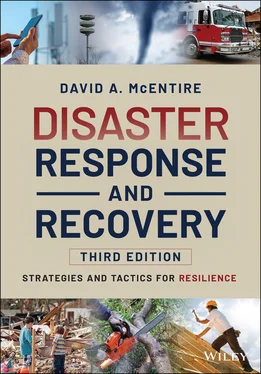David A. McEntire - Disaster Response and Recovery
Здесь есть возможность читать онлайн «David A. McEntire - Disaster Response and Recovery» — ознакомительный отрывок электронной книги совершенно бесплатно, а после прочтения отрывка купить полную версию. В некоторых случаях можно слушать аудио, скачать через торрент в формате fb2 и присутствует краткое содержание. Жанр: unrecognised, на английском языке. Описание произведения, (предисловие) а так же отзывы посетителей доступны на портале библиотеки ЛибКат.
- Название:Disaster Response and Recovery
- Автор:
- Жанр:
- Год:неизвестен
- ISBN:нет данных
- Рейтинг книги:5 / 5. Голосов: 1
-
Избранное:Добавить в избранное
- Отзывы:
-
Ваша оценка:
- 100
- 1
- 2
- 3
- 4
- 5
Disaster Response and Recovery: краткое содержание, описание и аннотация
Предлагаем к чтению аннотацию, описание, краткое содержание или предисловие (зависит от того, что написал сам автор книги «Disaster Response and Recovery»). Если вы не нашли необходимую информацию о книге — напишите в комментариях, мы постараемся отыскать её.
The new edition of the standard textbook in the field, updated with new studies and practical guidelines for reacting to the complexities of today’s disasters Disaster Response and Recovery: Strategies and Tactics for Resilience
Disaster Response and Recovery: Strategies and Tactics for Resilience, Third Edition
Disaster Response and Recovery — читать онлайн ознакомительный отрывок
Ниже представлен текст книги, разбитый по страницам. Система сохранения места последней прочитанной страницы, позволяет с удобством читать онлайн бесплатно книгу «Disaster Response and Recovery», без необходимости каждый раз заново искать на чём Вы остановились. Поставьте закладку, и сможете в любой момент перейти на страницу, на которой закончили чтение.
Интервал:
Закладка:
For these reasons, Disaster Response and Recovery: Strategies and Tactics for Resilience has been written. Its goal is to integrate the lessons provided by both researchers and professionals, updating the field with current studies and practical guidelines. Rather than address these reactive phases as if they were the only responsibilities of today’s emergency managers, this book attempts to illustrate that successful warning, evacuation and other disaster functions require advanced preparedness measures and careful implementation. Recovery likewise provides a prime opportunity to implement change, thereby reducing the probability and consequences of future disasters.
Of course, no book can provide sufficient or fail‐proof ideas on how to react successfully to the complexities of today’s disasters, and the reader should not consider the information in this text to be the best or only way to respond to or recover from deadly, destructive and disruptive events. In spite of this fact, it is hoped that this volume will be of benefit to students, emergency managers, and others interested or involved in disaster management.
In order to meet these goals, the book provides a thorough review of the challenges confronting emergency managers and others after disasters and discusses recommendations for their resolution.
Chapter 1shares background information about disasters, emergency management, and types of hazards and their interaction. Chapter 1 likewise discusses the consequences of disasters so you may know what to expect in their aftermath.
Chapter 2helps you recognize the large number of individuals and agencies that participate in response and recovery operations. This includes public servants, government departments, private and nonprofit organizations, and citizen volunteers.
Chapter 3covers human behavior in time of collective stress. It challenges widely held views and offers a more accurate view of disaster behavior.
Chapter 4identifies two theoretical approaches to the management of disasters. The advantages and disadvantages of the traditional and professional models are also explored.
Chapter 5mentions how the initial steps of hazard detection, warning, evacuation, and sheltering may protect people’s lives.
Chapter 6discusses several disaster functions including search and rescue, emergency medical care, mass fatality management and stress counseling. It describes how best to care for those who have been affected by disasters.
Chapter 7explains what can be done to successfully deal with the media/social media, donations and volunteers after a disaster. It will help you know how to manage public relations and community resources.
At this point, the book transitions from response to recovery. Damage assessment, disaster declarations, and debris management are the topics covered in Chapter 8.
In Chapter 9, the process of recovery is investigated along with its relation to mitigation. The types of disaster assistance programs are uncovered along with ways to reduce vulnerability.
Typical problems during response and recovery operations are exposed in Chapter 10. The difficulties associated with communication, coordination, decision making, transportation, politics, special populations, legal issues and record keeping are explained to help you fulfill your obligations as an emergency manager.
Chapter 11points out that technological tools and organization structure will improve disaster management and coordination among pertinent actors.
Chapter 12helps you understand the challenges of the future by looking at the lessons of prior disasters and the nature of emerging threats.
The final chapter of the book focuses on how to develop disaster resilience. Chapter 13specifically underscores the value of preparedness, improvisation, spontaneous planning, leadership, and professionalism for you as an emergency manager.
Learning and Teaching Aids
While reading each of the chapters, you will find helpful aids whether you are a student or an instructor.
Starting Point/Pretest: This assessment tool is an online test delivered through the book’s companion web site. It enables you to focus reading comprehension on the areas where you are weakest.
“What You’ll Learn…” and “After Studying This Chapter…”: These bulleted lists describe the topics to be covered in each chapter.
Goals and Outcomes: This bulleted list makes explicit the learning objectives for each chapter.
For Example boxes: Shorter real‐world situations that illustrate the central points of each section of the chapter.
Case Study boxes: Longer real‐world situations that illustrate key issues in the chapters.
Self‐Check Questions: These inquiries help the student review the material presented in each section of the chapter before continuing on with the remainder of the text.
Key Terms: A list of major concepts, including definitions, provided at the end of each chapter.
Summary Questions: True/false and multiple‐choice questions that capture the main points of each chapter to test student mastery of key issues and content.
Review Questions: Short‐answer questions that remind the student of the central recommendations covered in each section of the chapter.
Applying This Chapter Questions: Short‐answer questions that invite the student to consider new situations and how they would deal with alternative scenarios.
You Try It!: Open‐ended questions that allow the students to go beyond the information presented in the test and examine how they would react in real‐world contexts.
Access Your Understanding/Post‐Test: This final test for the chapter is online in the text’s website. It repeats the initial test questions in order to illustrate learning and comprehension while reading the chapter.
Acknowledgments
Appreciation is expressed to several organizations and individuals that have helped significantly in the development of Disaster Response and Recovery . Although I alone am responsible for the content of this book, I am indebted first and foremost to the Federal Emergency Management Agency for a grant that made much of the initial research for this text possible. Gratitude is also conveyed to Wayne Blanchard, the former FEMA Higher Education Program Manager, for his ideas and insight regarding the theoretical and practical nature of post‐disaster emergency management operations.
Special recognition is also warranted for the contributions of Siddik Ekici, Sarah Mathis and Kristina Cramb, three graduate students in the Department of Public Administration at the University of North Texas. These dedicated research assistants eagerly assembled additional information and materials for the first literature search. They also provided helpful case studies and worked on the extensive bibliography for this book.
I am also thankful for the knowledge and expertise of several scholars and practitioners that provided useful recommendations on earlier drafts of the book. These reviewers included Danny Peterson (Arizona State University), Phil Politano (Onondaga Community College), James Richardson (San Antonio Community College), William L. Waugh Jr. (Georgia State University), Cherlyn Wilhelmsen (University of Idaho), and Stacy Lynn Willet (University of Akron), Jane Kushma (Jacksonville State University), and DeeDee Bennett (University at Albany). The constructive advice of Gregg Dawson, Steve Reddish, Leland Baker, and other professional emergency managers is likewise noted.
I also wish to recognize my wonderful daughters ‐ Ashley Layton, Kailey Birchall and Madison McEntire ‐ for their assistance in developing the supplementary materials for the text. Their contributions have definitely made an overwhelming task more manageable.
Читать дальшеИнтервал:
Закладка:
Похожие книги на «Disaster Response and Recovery»
Представляем Вашему вниманию похожие книги на «Disaster Response and Recovery» списком для выбора. Мы отобрали схожую по названию и смыслу литературу в надежде предоставить читателям больше вариантов отыскать новые, интересные, ещё непрочитанные произведения.
Обсуждение, отзывы о книге «Disaster Response and Recovery» и просто собственные мнения читателей. Оставьте ваши комментарии, напишите, что Вы думаете о произведении, его смысле или главных героях. Укажите что конкретно понравилось, а что нет, и почему Вы так считаете.












